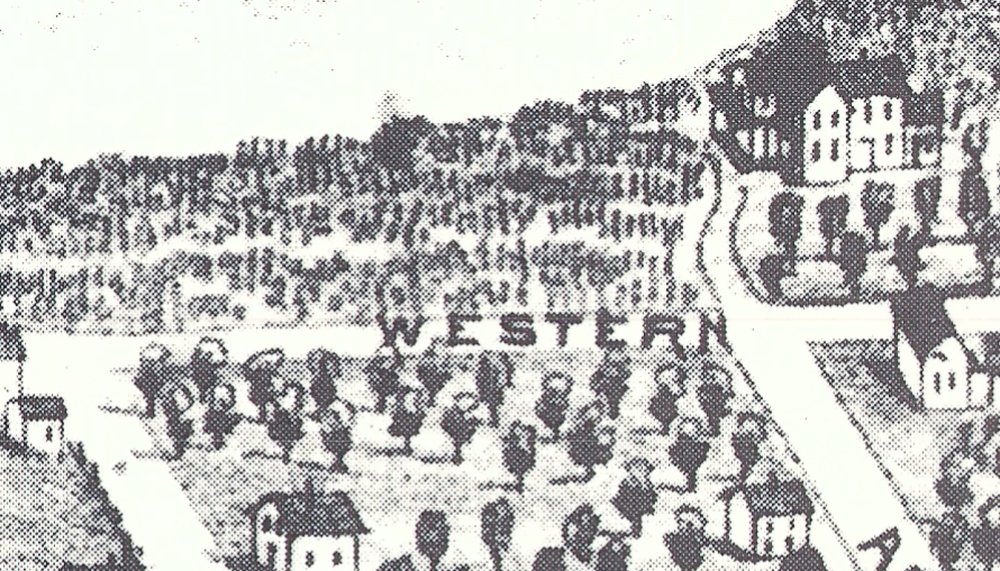Washington Square Park
Alone among all the developers in Stillwater during the 19th Century, William Holcombe set aside some of his development for public or open space. Block 21 in Holcombe’s Addition was dedicated to the public as Washington Square.
However Holcombe was not entirely altruistic. He located his public square across the street (Western Row, now S. Greeley Street) from his own palatial residence, so the Square both extended the open view from his front windows, as well as making the appearance of his house more impressive.
In the late 18th and early 19th centuries, the notion of a public space was quite common.
This common space was typically undeveloped in any way; it might be used for pasture, military drills, gathering twigs and sticks for firewood kindling, or a myriad of other uses.
Whether Holcombe designated Washington Square in the traditional older sense of a public commons for use as a pasture, or in the evolving sense of it as a public park as we understand that term today, will probably never be known. The fact that he named it a Square probably indicates the traditional older use; the fact that it is today known as Washington Square Park is evidence of the current meaning and use of this public space.
But Holcombe's generosity, however self-serving, did not extend to his two sons, William and Edwin. After their father's death in 1870, the two brothers attempted to reclaim the Square.
City Park
While some of our people have been urging the City Council to take measures to have the property given to the city by Wm. Holcombe, Sen., for a park, [by the time of this newspaper article, the notion of a "park" was well established] secured by deed or otherwise, the Holcomb brothers have not been wholly idle. A complaint has been filed in the district court, alleging that since the first day of June, 1872, E. V Holcomb and William Holcomb have been the owners and entitled to the possession of 'Washington square" in Holcombe’s Addition, and that in 1874, the city entered upon and took possession of the said premises.
The plaintiffs ask to have immediate possession given them, and such other relief as the court may grant. The necessary papers were served upon the city clerk last Monday, thus placing the matter where the city will probably have to take action or lose the property. It has generally been the understanding that while Mr. Holcomb was mayor, in 1867, we believe, he gave the property to the city for park purposes, and he being the executive officer of the city, it was supposed he would have the proper papers executed and put on record; but nothing but verbal testimony has thus far been adduced that he intended to give it to the city. In 1874, the city had the property enclosed with a fence, and virtually took possession of it. It may be possible that Mr. Holcombe intended to make the gift, conditioned on the city's improving the same immediately, in which case the property would now revert to his heirs.
—Stillwater Lumberman, April 30, 1875.
There is no evidence that the square has ever been used for other than a public purpose. Children growing up in the area used it as a playground, although in those earlier days, the equipment available was little more than a set of swings and a sandbox.
In 2007, the Park received a complete makeover as described in a Pioneer Press article on May 29, 2007:
Tom and Sherry Armstrong, the benefactors behind the popular Teddy Bear Park in downtown Stillwater, are now picking up the tab for $1.3 million in improvements to Washington Square, the city’s first public park.
When the park reopens in mid-August, it will feature a new picnic shelter, a gazebo, restrooms, a trail system and a 17-stall parking area.
The Armstrongs offered to adopt the park last year after noticing its massive oaks seemed to be doing poorly during very dry weather and the park didn’t seem to have many visitors.
“We really thought the park should have a sprinkler system because if we lost those (oaks), we’d lose the whole park,” Tom Armstrong said. “They’re such gorgeous trees. The trees itself make it a pretty park, so we’re just adding to that a little bit.”
Although the park had new playground equipment, it was not being used, Armstrong said. “We drive by all the time and thought that it needed some work,” he said. “It didn’t have the infrastructure. The picnic shelter’s roof was falling off. The park didn’t have lights; it didn’t have restrooms.”
After the city accepted the Armstrongs’ offer, the couple hired Thorbeck Architects, the Minneapolis architecture firm that designed Teddy Bear Park, to redesign Washington Square. They selected a Victorian theme for the new park structures and lights because of the park’s location in one of the city’s oldest sections.
The Armstrongs have been hands-on philanthropists: They picked the metal columns and aluminum friezes for the picnic pavilion that are on special order from England, asked that the playground slides be reconfigured so they would no longer be directly in the sun, and requested special benches covered with canopies called strombellas “because sitting out in the sun, moms get a little fried sometimes,” Tom Armstrong said.
Tom and Sherry Armstrong grew up in St. Paul and lived in Stillwater during the 1980s. Tom Armstrong later worked for Dell Inc. in Austin, Texas, and retired from the company as vice president and assistant treasurer. They moved back to Stillwater a few years ago.
The Armstrongs decided to focus on public parks “because they belong to everybody,” Armstrong said. “It’s nice for them to be in good shape so everybody can enjoy them.”
They hope people who live near Washington Square will take advantage of the park’s improvements.
“For us, it’s seeing it get used. That’s the return on the investment,” he said. “I really think it’s a jewel in the city’s landscape and to not have people using it is a crime. To have people use it and to make it more user-friendly, for us, it’s worth it.”
—Donald Empson

